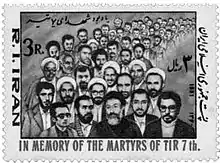Hafte Tir bombing
On 28 June 1981 (7 Tir 1360 (Hafte Tir – هفت تیر) in the Iranian calendar), a powerful bomb went off at the headquarters of Islamic Republic Party (IRP) in Tehran, while a meeting of party leaders was in progress. Seventy-three leading officials of the Islamic Republic of Iran were killed, including Chief Justice Ayatollah Mohammad Beheshti[1][2][3] the second-most powerful figure in the Iranian Revolution (after Ayatollah Ruhollah Khomeini). The Iranian government first blamed SAVAK and the Iraqi regime. Two days later, the People's Mujahedin of Iran was accused [4][5][6][7][8][9] by Khomeini.[10]
| Hafte Tir bombing | |
|---|---|
 Martyrs of 7th Tir on stamp | |
| Location | Tehran, Iran |
| Coordinates | 31.254825°N 29.993677°E |
| Date | 28 June 1981 20:20 local time (UTC+3) |
| Target | IRP leaders |
Attack type | Suicide bombing |
| Deaths | 73 |
Bombing

On 28 June 1981 the Hafte tir bombing occurred killing the chief justice and party secretary Ayatollah Mohammad Beheshti, four cabinet ministers (health, transport, telecommunications and energy ministers), twenty-seven members of the Majlis, including Mohammad Montazeri, and several other government officials.[1][2][3]
Immediate aftermath
Khomeini accused the PMOI to be responsible and, according to BBC journalist Baqer Moin, the Mujahedin were "generally perceived as the culprits" for the bombing in Iran.[11] The Mujahedin never publicly confirmed or denied any responsibility for the deed,[12] but stated the attack was ‘a natural and necessary reaction to the regime's atrocities.’ The bomber was identified as a young student [10] and Mujahedin operative by the name of Mohammad Reza Kolahi, who had secured a job in the building disguised as a sound engineer.[13][14][15]
Iranian judicial proceedings, views and commemoration
Assassinations of "leading officials and active supporters of the regime by the Mujahedin were to continue for the next year or two," though they failed to overthrow the government.[16]
According to Tasnim, it is not possible that MEK to be fully responsible for the incident, and the bomb had been transmitted to Iran or built by military technicians in the country, with the help of Western and Israeli spy services. In other words, the United States and Israel, with the sophisticated technology of that day, designed the bomb and plan of operation then presented the bomb and plan to MEK for operating.[17]
To commemorate the event several public places in Iran including major squares in Tehran and other cities are named “Hafte Tir”.[18]
Analysis
According to Ervand Abrahamian, "whatever the truth, the Islamic Republic used the incident to wage war on the Left opposition in general and the Mojahedin in particular."[19]
According to Kenneth Katzman, "there has been much speculation among academics and observers that these bombings may have actually been planned by senior IRP leaders, to rid themselves of rivals within the IRP."[20]
The 2006 U.S. department of state Country report says that "In 1981, the MEK detonated bombs in the head office of the Islamic Republic Party and the Premier's office, killing some 70 high-ranking Iranian officials."[21]
Assassination of Mohammad-Reza Kolahi
Mohammad-Reza Kolahi, accused of being involved in the bombing, was murdered in 2015.[22][23] Kolahi was living in the Netherlands under false identity of Ali Motamed (Persian: علی معتمد) as a refugee, was married to an Afghan woman and had a 17-year-old son.[23] Iran denied it was involved in the murder.[22]
See also
References
- "Religion in Iran – Terror and Repression", Atheism (FAQ), About
- "Eighties club", The Daily News, June 1981
- "Iran ABC News broadcast", The Vanderbilt Television News Archive
- Colgan, Jeff (31 January 2013). Petro-Aggression: When Oil Causes War. Cambridge University Press 2013. p. 167. ISBN 978-1-107-02967-5.
- S. Ismael, Jacqueline; Perry, Glenn; Y. Ismael, Tareq (5 October 2015). Government and Politics of the Contemporary Middle East: Continuity and change. Routledge (2015). p. 181. ISBN 978-1-317-66283-9.
- Newton, Michael (17 April 2014). Famous Assassinations in World History: An Encyclopedia. ABC-CLIO (2014). p. 27. ISBN 978-1-61069-286-1.
- Pedde, Nicola. "ROLE AND EVOLUTION OF THE MOJAHEDIN E-KA". ojs.uniroma1.
- McGreal, Chris. "Q&A: what is the MEK and why did the US call it a terrorist organisation?". theguardian. Retrieved 21 September 2012.
- Goulka, Jeremiah; Larson, Judith; Wilke, Elizabeth; Hansell, Lydia. "The MEK in Iraq (2009)" (PDF). rand.
- "Enemies of the Clergy", Time, 20 July 1981
- Moin, Baqer, Khomeini, Thomas Dunne Books (2001), p. 241
- O'Hern, Steven K. (2012). Iran's Revolutionary Guard: The Threat that Grows While America Sleeps. Potomac Books. ISBN 978-1-59797-701-2.
- (Persian website) Archived 2009-06-28 at the Wayback Machine
- Boffey, Daniel. "Death of an electrician: how luck run out for dissident who fled Iran in 1981". the guardian. Retrieved 14 January 2019.
- "IRANIAN GOVERNMENT EXECUTES 27 IN CRACKDOWN ON LEFTIST GROUPS". NYT.
- Moin, Baqer, Khomeini, Thomas Dunne Books, (2001), p.243
- "ابهاماتی از حادثه هفت تیر که هرگز پاسخ داده نشد!". tasnimnews. Retrieved 29 June 2017.
- Google Maps
- Abrahamian, Ervand (1989). Radical Islam: The Iranian Mojahedin. I.B. Tauris. pp. 219–220. ISBN 978-1-85043-077-3.
- Kenneth Katzman (2001). "Iran: The People's Mojahedin Organization of Iran". In Albert V. Benliot (ed.). Iran: Outlaw, Outcast, Or Normal Country?. Nova Publishers. p. 101. ISBN 978-1-56072-954-9.
- "Background Information on Designated Foreign Terrorist Organizations". www.state.gov. Retrieved 10 December 2018.
- "The story behind Iran's 'murder plot' in Denmark", BBC
- "Another Twist In Mysterious Murder Of 1981 Tehran Bombing Suspect", Radio Free Europe/Radio Liberty, 30 May 2018, retrieved 1 June 2018